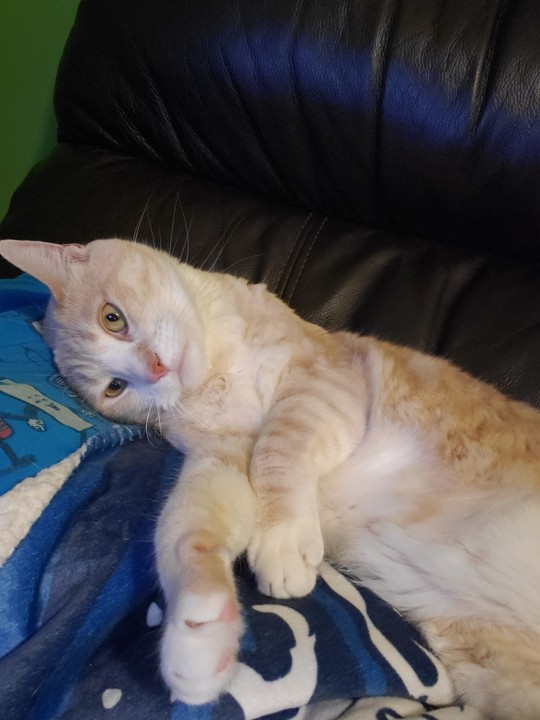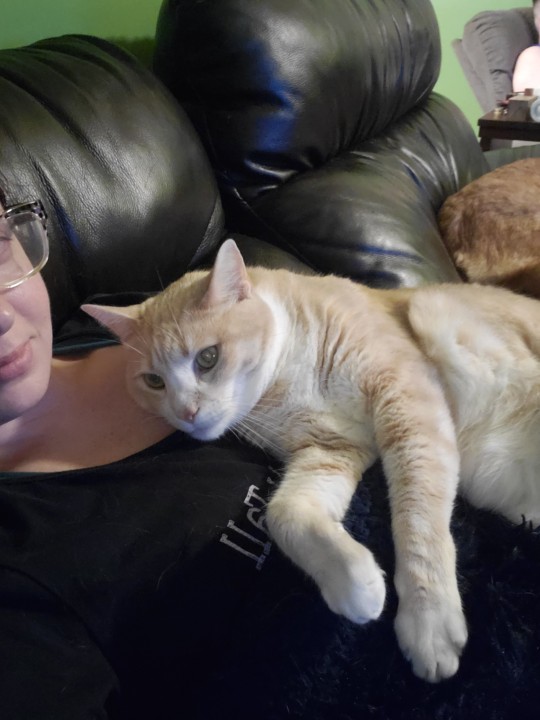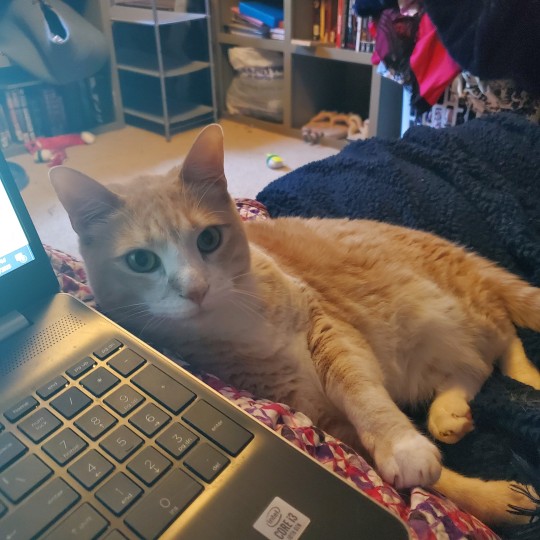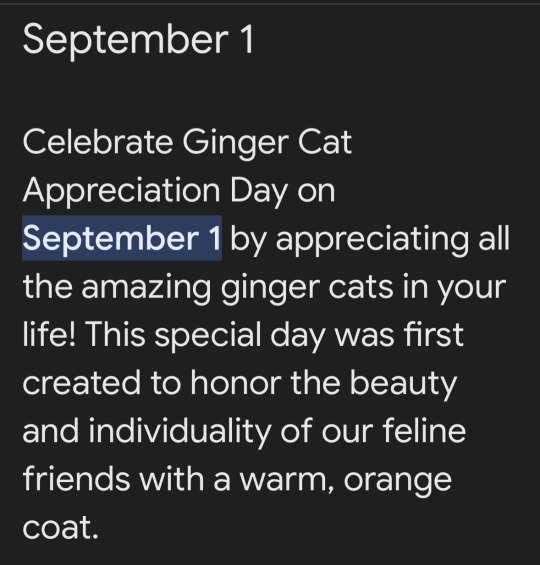#there IS a national rabbit day though and it's in September as well! the fourth Saturday of September so I'll do a Wascally post then
Explore tagged Tumblr posts
Text












ALL HAIL THE QUEEN ON HER BIG DAY
#an excuse to show off one of my cats?!#yes please!#but also how did i not already know about this?#it's going into my phone calendar#this is my baby boy Glitch#his coat coloration is literally called creamsicle!#he's the snuggliest fraidy cat that ever did live#his favorite place to lay is on my chest while I'm lounging#barring that his second favorite place to lay is literally anywhere else on my body#now i just have to look up if there's an international calico cat day...#turns out there's not so I'm just gonna pick one myself#there IS a national rabbit day though and it's in September as well! the fourth Saturday of September so I'll do a Wascally post then#ooh! I'll make the 12th of September my calico day so i can do a Pixel post right between them!#sorry for rambling in the tags!
652 notes
·
View notes
Text
Vaccine hesitancy, molecular mimicry, and blood clots (oh my!)
There were many mixed messages in the world of coronavirus last week. Just as it appears that Michigan is the lead state in the fourth wave of the virus, the US is about to hit a “vaccine wall” as demand drops for vaccinations even though the supply is greatly improved. In the first three months of the rollout for the Pfizer, Moderna, and the Johnson & Johnson/Jantzen (J&J) vaccines, getting shots into arms of the most vulnerable has required a full court press from public health departments and the healthcare establishment, as well as persistence on the part of those trying to wrangle an appointment. The results from state to state have been uneven.
Figure 1

So far 14 states have administered fewer than 75% of the doses distributed to them with Alabama having the lowest vaccination rate per capita. Twenty states have administered more than 80% of the doses distributed to them with the most vaccinations per capita in New Hampshire.[1]
Vaccine Hesitancy:
The good news for those who want to get vaccinated is that it is a whole lot easier to get an appointment now. That said, the goal of herd immunity is a long way off and with demand dropping for jabs, we may not get there. Vaccine hesitancy is an important reason for declining demand and that is a shifting picture.
In a study that was put out by the Kaiser Family Foundation (KFF) in December, 52% of Black Americans said they would “wait and see” before signing up for the vaccine while only 20% said they wanted the shot as soon as possible. The share of Black people who were skeptical of the vaccines was higher than for White respondents (36%) and Latinx (43%).[2]
By March of this year, 55% of Black respondents to another KFF survey said they had been vaccinated or wanted the vaccine as soon as possible. Twenty-four percent were still holding back. Blacks have been one of the hardest hit demographics of COVID-19 and that has, no doubt, played a part in changing minds. Another possible reason for the turnaround in willingness to get vaccinated is because there has been a concerted outreach effort tapping trusted sources such as Barack Obama, sports stars, and other influencers such as Black ministers to address vaccine hesitancy among Black people.
The Urban Institute’s September 2020 Coronavirus Tracking Survey, a nationally representative survey of adults ages 18-64, asked people whether in the last 12 months they had ever felt a doctor, other health care provider, or their staff judged them unfairly or discriminated against them based on their race/ethnicity, gender, gender identity, sexual orientation, a disability, or a health condition and about the consequences of these experiences. This survey indicated that perceptions of discrimination and unfair judgement while seeking health care were higher among Black adults than among Hispanic and White adults in the previous 12 months (September 2019-September 2020).[3]
Figure 2

A “food desert” is described as an urban area that does not have a grocery store within one mile or a rural area that does not have one within ten miles. There is also a “pharmacy desert” that generally occurs in primarily Black neighborhoods in urban areas as well as in rural areas. People of color are less likely to have a family primary care provider and so access to information about the individual’s risks and benefits of getting vaccinated from a trusted source, much less getting an appointment for the vaccine itself, is often more challenging than it is for White people. My guess is that these experiences and the barriers to appropriate care contributed to the initial skepticism among people of color generally and Black people specifically in the initial rollout phase.
FIGURE 3

Meanwhile, Republicans and Evangelical Christians were the most likely groups to say they will not get vaccinated, according to the KFF survey.[4] I do not have an explanation for that. I also don’t know how wearing masks got politicized last year. If anyone has an explanation that doesn’t involve a gang of Democratic, cannibal pedophiles, I am really interested in hearing it.
Molecular mimicry and autoimmune disease:
There are science-based reasons that some are reluctant to get vaccinated. An issue that has been little discussed publicly is molecular mimicry. The theory is that some part of the spike protein of SARS-CoV-2, the virus that causes COVID-19 and is replicated in our cells, is similar enough to our own tissues that the immune system starts attacking our own cells thinking that those cells are the virus. Thus, the vaccine could trigger an autoimmune disease like rheumatoid arthritis, lupus, multiple sclerosis, or other autoimmune condition.
In one study looking for similar protein sequences between the SARS-CoV-2 virus with protein sequences in humans and other mammals, as well as other human coronaviruses, the number of shared protein sequences at two particular sites was quite high for humans, rats, and mice but miniscule or not at all with other human coronaviruses, cats, dogs, rabbits, chimpanzees, gorillas, or macaques.[5] Sadly, the investigators did not include bats, which I think of as flying rats, but that’s just me. It has been hypothesized that the original source of COVID-19 was from bats. Could the virus have molecular mimicry with bats? If so, what does that mean for the species?
These authors believe that much of the damage seen in the “cytokine storm” that causes the worst damage in COVID-19 may, in fact, be due to this molecular mimicry between the virus and, for example, lung tissue. It should also be noted that molecular mimicry from the whole SARS-CoV-2 virus is much more likely than it is from a small part of the virus (the spike protein). If the vaccine can trigger an autoimmune disease, so can the whole virus.
The presence and level of autoantibodies (AAbs) that attack our own cells, frequently detected in patients with COVID-19, are significantly associated with hospitalization and more severe prognosis. Clinically, these patients are more likely to have respiratory distress, acute cardiac injury, acute kidney injury, multi-organ dysfunction with such common complications as coagulopathy and thrombocytopathy (put a pin in this one as it is also at play with blood clots). [6]
Blood Clots and the J&J and AstraZeneca (AZ) vaccines:
Last week the J&J vaccine rollout was put on pause by the Food and Drug Administration (FDA) because six women developed unusual blood clots after receiving this vaccination. This was six out of seven million shots given. Some saw this as an over-reaction by the FDA that would likely lead to more vaccine hesitancy. However, these blood clots are different from clots that occur from “the usual suspects” like oral contraceptives and smoking.
Figure 4

A normal number of platelets is between 150,000-450,000 per microliter of blood (there are 1,000 microliters in one milliliter). If you have less than 150,000 platelets per microliter, you have a deficiency called thrombocytopenia. In the clots associated with the viral vector vaccines (J&J in the US and AZ in Europe), the platelets tend to stick together in the veins of the brain, which causes a blockage known as a cerebral venous system thromboembolism (CVST). This creates back pressure of blood in the brain itself, causing damage in the same way a hemorrhagic stroke would. [7]
“Normal” clots are usually treated with a blood thinner called heparin. With vaccine-induced prothrombotic immune thrombocytopenia (VIPIT), there is a deficiency of platelets and so that treatment would only make things worse. While the Centers for Disease Control and Prevention (CDC) and the FDA are getting the word out to doctors not to use heparin, they are also looking for ways of figuring out which people are more at risk for this extremely rare complication. Putting the vaccine on pause was clearly the ethical thing to do and this kind of transparency gives me greater confidence in the vaccine rollout.
As is the case with molecular mimicry, the danger of VIPIT happening if a person gets COVID-19 is much higher than it is from either the J&J or the AZ vaccine.
“…If the mechanism is the same, one can speculate that the high occurrence in COVID-19 vs. vaccination is because the whole virus is more thrombogenic [likely to cause clots] than the spike protein alone.” Paolo Madeddu, professor of experimental medicine at the University of Bristol[8]
Symptoms associated with VIPIT include headache, tiny red spots under the skin, blurred vision, fainting or loss of consciousness, impaired movement in parts of the body, or coma. With either of these vaccines these blood clots, so far, only occurs 4-20 days after vaccination. Scientists believe that symptoms before or after that window are likely due to another cause.
It is important to note that COVID-19 itself has been reported to lead to thrombocytopenia (low blood platelets) in up to 41% of positive patients, with the figure going up to 95% of those with severe disease.[9]
Cause for cautious optimism:
Two separate studies published in the New England Journal of Medicine on April 9 indicated that in the case of the AZ vaccine, used in Europe, VIPIT was due to rogue antibodies against platelet factor 4 (PF4). This complication is similar to heparin-induced thrombocytopenia (HIT) and is diagnosed and treated the same way. It can be diagnosed with a lab test called ELISA that is pre-treated with PF4. If there is a big immune response, that means the patient has VIPIT. To be clear, there are lots of things that can cause blood clots and health professionals want to know what the cause is because the appropriate treatment is dependent on what is causing the problem. VIPIT from the AZ vaccine is treated with the administration of intravenous immunoglobins (IVG) and anti-coagulants. The J&J vaccine was not used in either of these studies and so we do not yet know if the same is true for that vaccine, but both are the same type of (viral vector) vaccine and both use an adenovirus as the viral vector.[10]
If we can get the one-and-done J&J vaccine back in use safely, that would be especially helpful for vaccinating unsheltered people. It would also be much easier to use in rural areas because J&J can be stored in a regular refrigerator unlike the Pfizer and Moderna vaccines that must be kept frozen.
My take:
For those who choose not to get vaccinated, for whatever reason, hoping to ride the coronavirus out, you should know that even without a vaccine, the SARS epidemic that hit Asia in 2002 did eventually go away, or, more likely, mutated to a less lethal virus. It took four years, but it can happen. However, that is not what always happens. Case in point, smallpox, which was around since at least the fourth century until it was declared eradicated by the World Health Organization in 1980. I don’t think I know anyone who has had smallpox and I may not know anyone who knows anyone who has had smallpox. In that case, the vaccine worked as intended.
Maybe you may feel like you are strong and healthy and even if you got COVID-19, you are unlikely to get significantly sick. Consider the possibility that you could be asymptomatic but still spread the disease. There are just no options that are completely risk free. Choose wisely.
[1]Romeo, A. (4/15/2021). America is about to hit a “vaccine wall” as demand drops—with or without Johnson & Johnson, Yahoo News. [2]Bunn, C. (4/12/2021). Vaccine hesitancy among Black Americans has turned a corner. Here’s why.”, NBC News. [3]Gonzalez, D., Skopor, L., McDaniel, M., Kenney, G.M. (4/2021). Perceptions of discrimination and unfair judgement while seeking health care, findings from the September 11-28 Coronavirus Tracking Survey, Urban Institute Health Policy Center. Retrieved from: https://www.urban.org/sites/default/files/publication/103953/perceptions-of-discrimination-and-unfair-judgment-while-seeking-health-care_0.pdf [4] Hamel, L., Lopez, L., Kearney, A., Brodie, M.(3/30/2021) KFF COVID-19 monitor: March 2021. Retrieved from: https://www.kff.org/coronavirus-covid-19/poll-finding/kff-covid-19-vaccine-monitor-march-2021/ [5]Kanduc, D., Shoenfeld, Y. (9/18/2020). Molecular mimicry between SARS-CoV-2 spike glycoprotein and mammalian proteomes: implications for the vaccine, Immunol. Res. doi: 10.1007/s12026-020-09152-6 [6]Macela, A, Kubelkovak, K. (3/22/2021). Why does SARS-Co-V-2 infection induce autoantibody production? Pathogens, 10(3). doi: 10.3390/pathogens10030380 [7]Taylor, A. (4/16/2021). Blood clot risks: comparing AstraZenica vaccine and the contraceptive pill, The Conversation. Retrieved from: https://theconversation.com/blood-clot-risks-comparing-the-astrazeneca-vaccine-and-the-contraceptive-pill-158652 [8]Russell, P. (4/15/2021). Vaccines carry far lower risk for rare blood clots than COVID, study shows, Medscape News UK [9] Op cit Taylor, A. (4/9/2021). [10] Grenacher, A., et. al. (4/9/2021). Thrombocytic thrombocytopenia after ChAdOx1 nCoV-19 vaccination, NEJM. doi:10.1056/NEJMoa2104840Schulz,NH, et. al. (4/9/2021). Thrombocytic thrombocytopenia after ChAdOx1 nCoV-19 vaccination, NEJM. doi: 10/1056/NEJMoa2104882
#vaccination#covidー19#astrazeneca vaccine#johnson and johnson#blood clots#molecular mimicry#autoimmune disease
4 notes
·
View notes
Text
aaaaaa i got tagged to do this by @princeleo !!!!! :0
and gfhgh tHANKS for the nice things you said omg,,, you’re one of my really cool mutuals and i’ve really enjoyed following you for as long as i have!!!! :>
name: amaris
nickname: ama, north
zodiac sign: leo sun, moon cancer, rising cancer
height: 5′1″ i am a smol
orientation: i’mmmm a panromantic ace???? not that i’ve ever actually been in a relationship though ¯\_(ツ)_/¯
nationality: american?? white?? w/e one it means
favorite fruit: oof idk uhhh i LOVE apples fresh from the tree/orchard i guess?? but omgg raspberries,,, OKAY last year this black raspberry bush grew out of NOWHERE in our backyard in the weedy part it’s been growing for a couple years but i just thought it was one of those huge thorny weeds haha they’re def not blackberries just black raspberries which is cool for one BUT THEY WERE really sweet and good??? thanks to whatever bird/squirrel/??? planted it lmao
favorite season: i really like fall!! a lot of it’s to do with the overall eerie/creepy/ominous sort of feel it tends to get around then i guess but also other stuff!! spring is also nice though i really love the rainy season and finding tadpoles lmao
favorite book: ummm idk i read a lot but a lot of it’s miscellaneous ya fiction and while a lot of it’s good/decent not much really ever jumps out at me to say for a favorite??? recently i’ve really enjoyed the naturals series by jennifer lynn barnes and ummm other good books to mention are shutter by courtney alameda, companions of the night by vivian vande velde, anddd,, yeah idk,,
favorite flower: i don’t think i have a favorite flower uhh. i like lilies of the valley, roses, marigolds, forget-me-nots, etc,,,,
favorite scent: the smell of burning leaves and also the fresh air tinged with pine out in the woods up north !!! :0
favorite color: the grayscale spectrum, really, from black to white mostly!!
coffee, tea, or hot cocoa: i really don’t drink any of theese all that often, but probably hot cocoa?? sweet chocolate-y sort of coffees are also really good though!!
average sleep hours: usually from around 7 to 9?? sometimes as little as 3 and as much as like 11 though haha so yeah it depends.
cat or dog person: definitely a cat person! :o dogs are nice but yeah definitely cats for me haha. technically a rabbit person as well though :p
favorite fictional character: agH oh gosh??? idk i’m terrible at picking favorite charactres,,, honestly my oc’s are my top kids of all time but that’s p biased anyways sO aside from that uh: alex from oxenfree?? as well as nico di angelo from pjo, um,,,,,, keith and lance from voltron?? IDK that’s,,, good enough for now, ,,
number of blankets you sleep with: okay it’s supposed to be three but lately i’m too lazy to fix them so i’ve been sleeping on top of those three w fourth one on top lmao,, it used to be worse though bc i had like seven i’d sleep on top of with like two-three on top SO. ????
dream trip: idk i just like hanging around the great lakes particularly in the upper peninsula and i’m p happy just doing that. i guess i’d really like to go to roswell one day though just to see all the alien themed stuff???
blog created: okay THIS blog i made in september 2014, but if you want to know how long i’ve been on tumblr my first blog i made in june 2011???
number of followers: 314 at the moment
WHO DO I TAG? @eldritchfriend, @r-7038xx, @ioannemos, @dreamikyu, @dremvr ???? if you guys don’t want to do this please don’t worry about it, sorry, i’m really not sure who’s okay with being tagged for these kind of things!!!! and likewise if i didn’t tag you and you want to do this please def go ahead and do it!!! o vo
7 notes
·
View notes